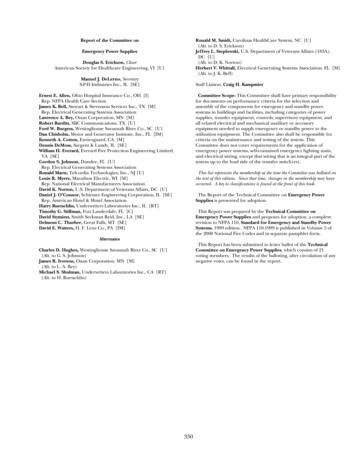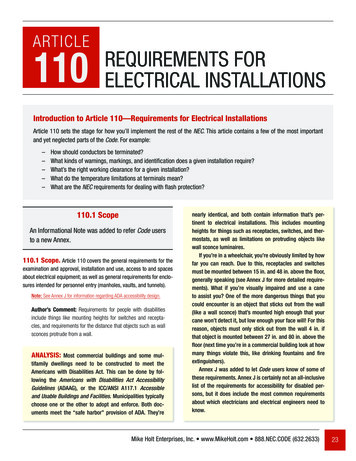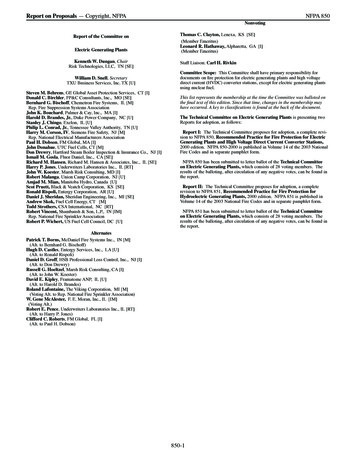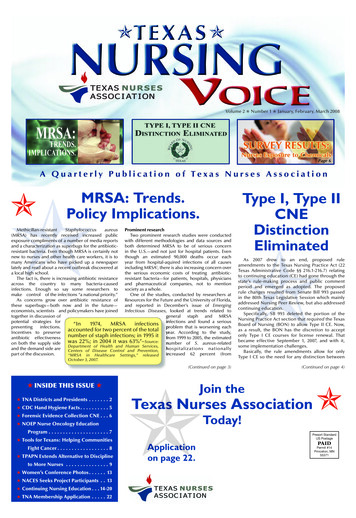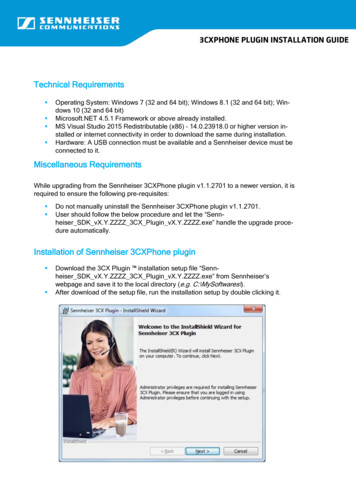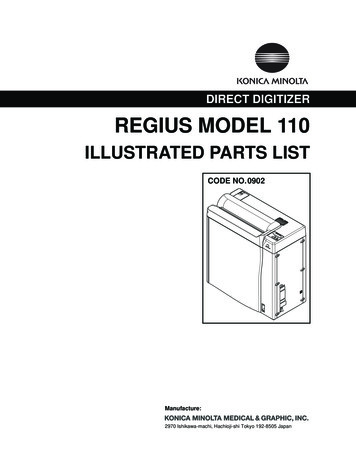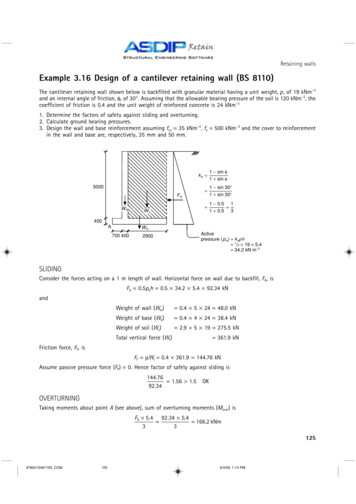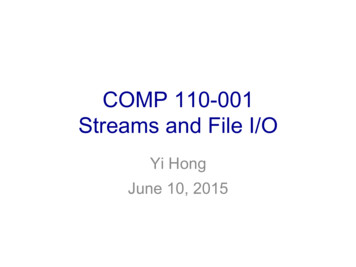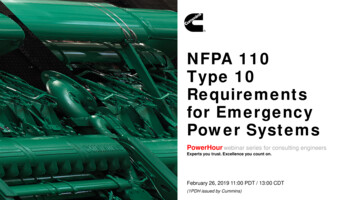
Transcription
NFPA 110Type 10Requirementsfor EmergencyPower SystemsPowerHour webinar series for consulting engineersExperts you trust. Excellence you count on.February 26, 2019 11:00 PDT / 13:00 CDT(1PDH issued by Cummins)
Welcome!PowerHour is designed to help our engineer partners to Keep up to date on products, technology, and codes and standards development Interact with Cummins experts and gain access to ongoing technical support Participate at your convenience, live or on-demand Earn Professional Development Hours (PDH)Technical tips: Audio is available through teleconference, or your computer (don’tforget to unmute) You are in “listen only” mode throughout the event Use the WebEx Q&A Panel to submit questions, comments, andfeedback throughout the event. We will provide sufficient Q&A time afterpresentation If you lose audio, get disconnected, or experience a poor connection,please disconnect and reconnect Report technical issues using the WebEx Q&A Panel, or emailpowergenchannel@cummins.com2
Meet your panelistsCummins presenter:Cummins facilitator:HighResolutionHeadshotMichael SanfordTechnical Marketing SpecialistCummins Inc.Tom Bakritzes,Global Sales Training ManagerCummins Inc.Your local Cummins contacts: Western Canada: Ian Lindquist (ian.Lindquist@cummins.com), Western Canada Region South IL, East MO: Jeff Yates (jeffrey.yates@cummins.com), Central Region Eastern Canada: Gianluca Ianiro (gianluca.ianiro@cummins.com), Eastern Canada Region TX, OK, AR, LA, MS, AL, Western TN: Scott Thomas (m.scott.thomas@cummins.com), Gulf Region AZ, ID, NM, NV: Carl Knapp (carl.knapp@cummins.com), Rocky Mountain Region FL, GA, NC, SC, Eastern TN: Robert Kelly (robert.kelly@cummins.com), South Region CO, MT, ND, UT, WY: Chris Scott (Christopher.l.scott@cummins.com), Rocky Mountain Region NY, NJ, CT, PA, MD: Charles Attisani (charles.attisani@cummins.com), East Region Northern IL, IA: John Kilinskis (john.a.kilinskis@cummins.com), Central Region CA, HI: Brian E Pumphrey (brian.pumphrey@cummins.com), Pacific Region UP of MI, MN, East ND, WI: Michael Munson (michael.s.munson@cummins.com), Central Region WA, OR, AK: Tom Tomlinson (tom.tomlinson@cummins.com), Pacific Region NE, SD, West MO, KS: Earnest Glaser (earnest.a.glaser@cummins.com), Central Region For other states and territories, email powergenchannel@cummins.com or r3
DisclaimerThe views and opinions expressed in thiscourse shall not be considered the officialposition of any regulatory organization andshall not be considered to be, nor be reliedupon as, a Formal Interpretation.Participants are encouraged to refer to theentire text of all referenced documents. Inaddition, when it doubt, reach out to theAuthority Having Jurisdiction.4
Course ObjectivesNFPA 110 Type 10 Requirements for Emergency Power SystemsThe 10-second start has been a point of pride for quality generator set manufacturers for many years. Thecapability of an emergency power system to deliver acceptable power within 10 seconds of an outage has madeengine-based generator sets the standby power system of choice for healthcare and many other critical powerfacilities. However, there has been some confusion in the industry regarding those critical 10 seconds andmethods of demonstrating compliance. This course will dive in to NFPA 110’s Type 10 requirement and willexamine the aspects that enable a power system to successfully meet the intent of the code and the impact thisrequirement may have on the way generator set and power systems are specified and designed.After completing this course, participants will be able to: Recognize NFPA 110 classifications of emergency and standby power systems. Identify key aspects and intent of NFPA 110 that impact equipment selection and design of generator setemergency power systems. Describe various strategies for ensuring generator set and system performance as they relate to NFPA 110Type 10 guidelines.5
NFPA 110 OverviewStandard for Emergency and Standby Power SystemsRequirements covering the performance of emergency and standby powersystems providing an alternate source of electrical power to loads in buildingsand facilities in the event that the primary power source fails.Covers installation, maintenance, operation, and testing requirements as theypertain to the performance of the emergency power supply system (EPSS).Intent of standard is to achieve maximum system reliability.6
NFPA 110 OverviewStandard for Emergency and Standby Power SystemsRequirements covering the performance of emergency and standby powersystems providing an alternate source of electrical power to loads in buildingsand facilities in the event that the primary power source fails.Covers installation, maintenance, operation, and testing requirements as theypertain to the performance of the emergency power supply system (EPSS).Intent of standard is to achieve maximum system reliability.7
EPSEmergency Power Source8
EPSSEmergency Power Supply System9
NFPA 110 OverviewClassification of Emergency Power Supply Systems4.2 Class.The class defines the minimum time, in hours, for which the EPSS isdesigned to operate at its rated load without being refueled orrecharged.4.3 Type.The type defines the maximum time, in seconds, that the EPSS willpermit the load terminals of the transfer switch to be without acceptableelectrical power.4.4 Level.This standard recognizes two levels for equipment installation, performanceand maintenance requirements.Level 1 systems shall be installed where failure of the equipment to performcould result in loss of human life or serious injuries.Level 2 systems shall be installed where failure of the EPSS to perform is lesscritical to human life and safety.4.4.14.4.2Reprinted with permission from NFPA 110-2016, Standard for Emergency and Standby Power Systems, Copyright 2015, National Fire Protection Association, Quincy, MA. This reprinted material isnot the complete and official position of the NFPA on the referenced subject, which is represented only by the standard in its entirety which can be obtained through the NFPA web site at www.nfpa.org.10
NFPA 110 OverviewClassification of Emergency Power Supply Systems4.2 Class.The class defines the minimum time, in hours, for which the EPSS isdesigned to operate at its rated load without being refueled orrecharged.4.3 Type.The type defines the maximum time, in seconds, that the EPSS willpermit the load terminals of the transfer switch to be without acceptableelectrical power.4.4 Level.This standard recognizes two levels for equipment installation, performanceand maintenance requirements.Level 1 systems shall be installed where failure of the equipment to performcould result in loss of human life or serious injuries.Level 2 systems shall be installed where failure of the EPSS to perform is lesscritical to human life and safety.4.4.14.4.2Reprinted with permission from NFPA 110-2016, Standard for Emergency and Standby Power Systems, Copyright 2015, National Fire Protection Association, Quincy, MA. This reprinted material isnot the complete and official position of the NFPA on the referenced subject, which is represented only by the standard in its entirety which can be obtained through the NFPA web site at www.nfpa.org.11
NFPA 110 OverviewClassification of Emergency Power Supply Systems4.2 Class.The class defines the minimum time, in hours, for which the EPSS isdesigned to operate at its rated load without being refueled orrecharged.4.3 Type.The type defines the maximum time, in seconds, that the EPSS willpermit the load terminals of the transfer switch to be without acceptableelectrical power.4.4 Level.This standard recognizes two levels of equipment installation ,performanceand maintenance.Level 1 systems shall be installed where failure of the equipment to performcould result in loss of human life or serious injuries.Level 2 systems shall be installed where failure of the EPSS to perform is lesscritical to human life and safety.4.4.14.4.2Reprinted with permission from NFPA 110-2016, Standard for Emergency and Standby Power Systems, Copyright 2015, National Fire Protection Association, Quincy, MA. This reprinted material isnot the complete and official position of the NFPA on the referenced subject, which is represented only by the standard in its entirety which can be obtained through the NFPA web site at www.nfpa.org.12
NFPA 110 OverviewClassification of Emergency Power Supply Systems4.2 Class.The class defines the minimum time, in hours, for which the EPSS isdesigned to operate at its rated load without being refueled orrecharged.4.3 Type.The type defines the maximum time, in seconds, that the EPSS willpermit the load terminals of the transfer switch to be without acceptableelectrical power.4.4 Level.This standard recognizes two levels for equipment installation, performanceand maintenance requirements.Level 1 systems shall be installed where failure of the equipment to performcould result in loss of human life or serious injuries.Level 2 systems shall be installed where failure of the EPSS to perform is lesscritical to human life and safety.4.4.14.4.2Reprinted with permission from NFPA 110-2016, Standard for Emergency and Standby Power Systems, Copyright 2015, National Fire Protection Association, Quincy, MA. This reprinted material isnot the complete and official position of the NFPA on the referenced subject, which is represented only by the standard in its entirety which can be obtained through the NFPA web site at www.nfpa.org.13
NFPA 110 OverviewClassification of Emergency Power Supply Systems4.3 Type.The type defines the maximum time, in seconds, that the EPSS willpermit the load terminals of the transfer switch to be without acceptableelectrical power.Reprinted with permission from NFPA 110-2016, Standard for Emergency and Standby Power Systems, Copyright 2015, National Fire Protection Association, Quincy, MA. This reprinted material isnot the complete and official position of the NFPA on the referenced subject, which is represented only by the standard in its entirety which can be obtained through the NFPA web site at www.nfpa.org.14
NFPA 110 OverviewClassification of Emergency Power Supply Systems4.3 Type.The type defines the maximum time, in seconds, that the EPSS willpermit the load terminals of the transfer switch to be without acceptableelectrical power.Reprinted with permission from NFPA 110-2016, Standard for Emergency and Standby Power Systems, Copyright 2015, National Fire Protection Association, Quincy, MA. This reprinted material isnot the complete and official position of the NFPA on the referenced subject, which is represented only by the standard in its entirety which can be obtained through the NFPA web site at www.nfpa.org.15
NFPA 110 OverviewClassification of Emergency Power Supply Systems4.2 Class.The class defines the minimum time, in hours, for which the EPSS isdesigned to operate at its rated load without being refueled orrecharged.4.3 Type.The type defines the maximum time, in seconds, that the EPSS willpermit the load terminals of the transfer switch to be without acceptableelectrical power.4.4 Level.This standard recognizes two levels for equipment installation, performanceand maintenance requirements.Level 1 systems shall be installed where failure of the equipment to performcould result in loss of human life or serious injuries.Level 2 systems shall be installed where failure of the EPSS to perform is lesscritical to human life and safety.4.4.14.4.2Reprinted with permission from NFPA 110-2016, Standard for Emergency and Standby Power Systems, Copyright 2015, National Fire Protection Association, Quincy, MA. This reprinted material isnot the complete and official position of the NFPA on the referenced subject, which is represented only by the standard in its entirety which can be obtained through the NFPA web site at www.nfpa.org.16
NFPA 110 OverviewClassification of Emergency Power Supply Systems4.2 Class.The class defines the minimum time, in hours, for which the EPSS isdesigned to operate at its rated load without being refueled orrecharged.4.3 Type.The type defines the maximum time, in seconds, that the EPSS willpermit the load terminals of the transfer switch to be without acceptableelectrical power.4.4 Level.This standard recognizes two levels for equipment installation, performanceand maintenance requirements.Level 1 systems shall be installed where failure of the equipment to performcould result in loss of human life or serious injuries.Level 2 systems shall be installed where failure of the EPSS to perform is lesscritical to human life and safety.4.4.14.4.2Reprinted with permission from NFPA 110-2016, Standard for Emergency and Standby Power Systems, Copyright 2015, National Fire Protection Association, Quincy, MA. This reprinted material isnot the complete and official position of the NFPA on the referenced subject, which is represented only by the standard in its entirety which can be obtained through the NFPA web site at www.nfpa.org.17
Concept CheckNFPA 110 defines “Type” as a) Minimum time, in hours, for which the EPSS is designed to operate at itsrated load without being refueled or recharged.b) Maximum time, in seconds, that the EPSS will permit the load terminals ofthe transfer switch to be without acceptable power.c) Redundancy level, number of emergency power sources, that the EPSS willinclude.d) Prototype testing requirements for emergency power source vendors.18
Concept CheckNFPA 110 defines “Type” as a) Minimum time, in hours, for which the EPSS is designed to operate at itsrated load without being refueled or recharged.b) Maximum time, in seconds, that the EPSS will permit the load terminals ofthe transfer switch to be without acceptable power.c) Redundancy level, number of emergency power sources, that the EPSS willinclude.d) Prot
NFPA 110 Type 10 Requirements for Emergency Power Systems. PowerHour. webinar series for consulting engineers. Experts you trust. Excellence you count on. 2. Welcome! PowerHour is designed to help our engineer partners to Keep up to date on products, technology, and codes and standards development Interact with Cummins experts and gain access to ongoing technical support .

